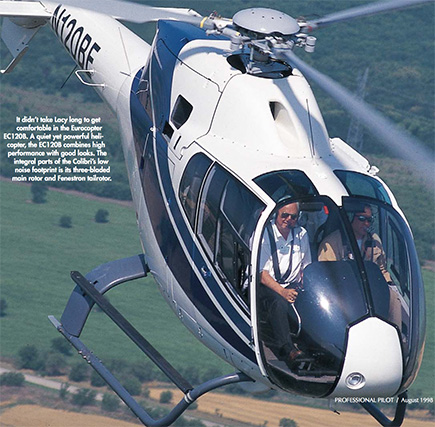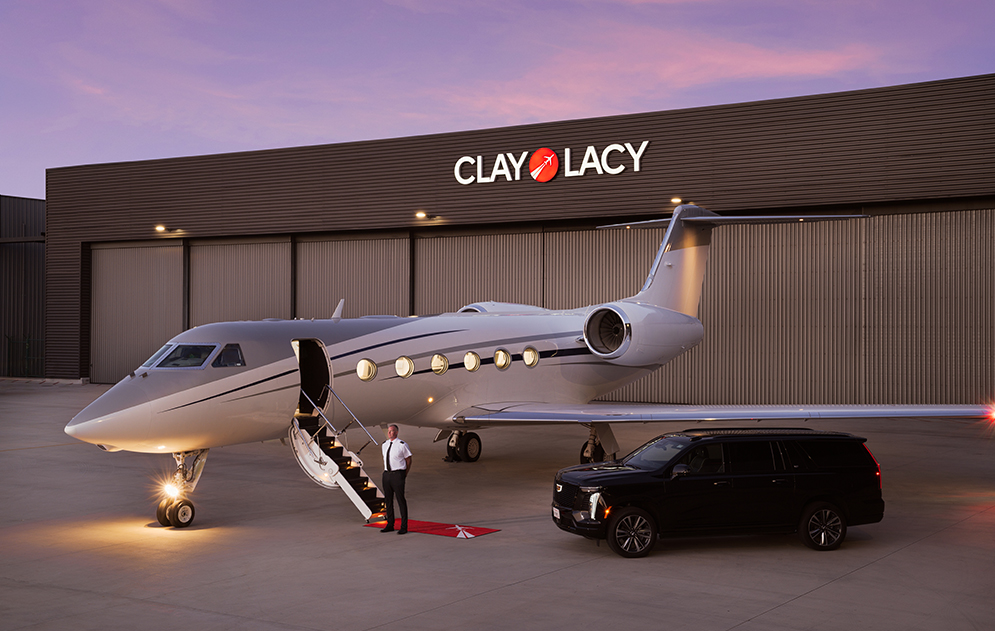
Eurocopter EC120B Colibri
By Clay Lacy – in August 1998 Professional Pilot Magazine’s “Flightcheck”
ATP/CFII/Helo/Sea. Gulfstream II/III/IV,
Learjet series, Hawker, Boeing 747
and 25 misc. type ratings.
EUROCOPTER REDEFINES THE ENTRY-LEVEL MARKET WITH ITS NEW SINGLE-ENGINE HELICOPTER.
EUROCOPTER has re-entered the light single-engine helicopter market with the all new five-place EC120B Colibri. A joint venture with China and Singapore, the EC120B is just now commencing first deliveries. When American Eurocopter suggested that we take EC120B production s/n 1 up for a flight, Clay Lacy set off to Grand Prairie TX to evaluate the helicopter.
I have been flying helicopters since 1957 and while I only have about 1500 hours in rotary-wing aircraft, I’ve had the opportunity to fly a number of different products, including the Bell 47 and 206 JetRanger, Enstrom and Sikorsky S-76. Over the years I’ve admired the technological innovation that Eurocopter has invested in its products and I was happy to have this chance to fly their latest offering, the EC120B.
After arriving at American Eurocopter’s Grand Prairie facility early in the morning, I sat down with Senior VP of Customer Service, Cary Brown, Dir of Marketing Support, Del Livingston, Dir of Marketing Communications, Brenda Rueland and Instructor/Demo Pilot, Tom Habdzlik. American Eurocopter President and CEO Christian Gras also came in to join us for awhile and to talk about some of the improvements that have been going on recently in the area of product support. The technical manuals and materials I reviewed on the EC120B were excellent, Tom Handzlik went over some of the more unique features of the product and Brenda Reuland gave me a short tour of the property that included a very impressive new blade overhaul facility.
The EC120B is Eurocopter’s newest helicopter and it was developed as a joint venture between China, Singapore and Eurocopter. This product gives the company a new entry-level helicopter and it is the first five-place Eurocopter since the Gazelle was introduced nearly 20 years ago.
While the EC120B is priced significantly below the A-Star, $795,000 (1998 dollars) compared with $1.105 million for the AS350- B2, it seems to offer a lot. The EC120B departs from the A-Star design in that it has a Spheriflex rotor system, as opposed to the Starflex system on the A-Star, and it has a ducted tailrotor Fenestron much like the AS135 and 365 series.
To date, four EC120s have been delivered—two in the US market and two overseas—with firm sales of 110 copies. The next available delivery position isn’t until the year 2000. Eurocopter plans to build 30 EC120s this year, 60 next year and 100 to 150 units a year thereafter. Considering the order backlog and the attractive entry-level pricing, it looks like this helicopter is on track to become just as popular as the A-Star line.
VTOL HERITAGE
Eurocopter is a French/German collaboration jointly owned by Airbus and Daimler-Benz with a product line that’s an amalgamation of Aerospatiale and MBB helicopters. The current mix includes nine civil helicopters—the EC120B, AS350 (A-Star) series, AS355 (TwinStar) series, BO105 and BK117 series along with the EC135 light twin, eight-passenger AS365 and AS332 Super Puma heavy twin. This family of VTOL equipment covers the VTOL spectrum, in terms of performance and mission capabilities, and runs in price from the $795,000 EC120B to the $11.5 million Super Puma. American Eurocopter is responsible for North American sales and its employee base of 250 looks after final assembly and customization of helicopters for end users.
Eurocopter has always had a reputation of being a technological leader and it’s well deserved. The company has been building composite main rotorblades since the 1960s, which are on condition with no life limits and this, in itself, is a real leap forward. The main blades on Bell JetRangers, for example, have to be replaced every 5000 hours at a cost of $60,000. Eurocopter has also been building composite rotorheads since the 1960s, which have proven to be very reliable and low in maintenance.
The EC120B certainly seems to carry forward this tradition of technological innovation with its composite three-bladed main rotors, a new generation Spheriflex rotorhead, an all-new vehicle and engine multifunctional display (VEMD) system and a new Fenestron design which, Livingston explained, qualifies this as the quietest civil helicopter ever built.
PREFLIGHT
We did our preflight in the hangar before towing the EC120B out to a starting position. The walkaround was easy and there are convenient built-in steps to get up to the engine/transmission compartment, which had excellent accessibility to all components.
One of the nice features of this aircraft is the huge baggage area positioned right below the mechanical systems, which can accommodate 970 lbs of cargo. Rear cargo doors allow you to take oversized cargo and I thought this was a great feature. With the cargo doors open, you can stand up and look back into the tail section to see the one piece, heavy-duty, driveshaft to the Fenestron. The cabin features crash-resistant seats and fuel systems certified to new JAR 27 regs and there’s a sliding door on the left-hand side.
The Eurocopter EC120B is powered by a Turbomeca Arrius 2F with 504 shp and a max continuous power of 449 shp. Turbomeca engines have always had a good reputation for high reliability and good power and they always seem to put out the power they’re supposed to.
Flying endurance is four hours with 109.9 gal of fuel, much of which is held in a contoured tank fitted below the baggage area that feeds up to the engine. Forward of the belly fuel tank is a large, easily detachable access panel that allows you to get to all systems under the flightdeck easily.
The aircraft sits high on its skids but it was an easy step up into the cabin. I found the flightdeck to be very comfortable and well laid out. You immediately notice the excellent visibility of the EC120B, both fore and aft, as there’s no structure between the three forward-facing passenger seats and the front seating.
One feature that particularly impressed me was the VEMD, which is positioned high on the instrument panel with an easy-to-view active-matrix LCD screen that displays your first limit numbers. You simply enter passenger and baggage weights and the VEMD calculates your first limits on takeoff and displays max weight at which you can hover in and out of ground effect. As you fly it recalculates weights, temperature and performance so that the pilot doesn’t have to constantly make computations. It’s certainly a great feature in terms of cutting down on pilot workload.
FLYING THE EC120B
With Handzlik in the left seat and myself in the right one, we prepared for liftoff at a gross weight of 3300 lbs, which included two pilots, one passenger with almost full fuel. Although it’s necessary to manually control temperature on start, this was easy to accomplish. Once the engine was up to ground idle, I brought it to full power RPM, lifted off and stabilized at a 5-ft hover.
We accelerated to 40 kts at 5-ft AGL and transitioned to a best climb-out speed of 65 kts, which gave us an impressive 1600-fpm climb. Handzlik explained that with full fuel and two passengers, the EC120B will climb to 10,000 ft in eight min, starting off at about a 1500-fpm climb and stabilizing out at about 800 fpm.
It was a nice clear morning, although a little bumpy, and the first 20 min of our flight involved a circuit around downtown Dallas for photos before we headed to the practice area outside Grand Prairie. I found the EC120B to be a very responsive helicopter—it was easy to adapt to the control feel and within a few minutes I felt at home in this aircraft. Handzlik performed some maneuverability demonstrations and I was impressed with the excellent control authority during quick-pedal 90° turns. The EC120B has plenty of rudder authority.
Once we were over the practice area, we performed a couple of simulated autorotations with power recoveries followed by a climbout at max continuous power, which gave us a 1500-fpm rate of climb at 40 kts. Handzlik then shut off the hydraulic control boost and we flew around a little and did a normal approach to a landing. With the hydraulic boost off, the controls became heavy but the helicopter was easy enough to control. We turned the boost back on again, took off and made a couple more autorotations.
The first autorotation was a power cutoff on base leg followed by a power cutoff on downwind and a 180° change of direction to landing. The aircraft handled very well in all situations. Autorotations in the EC120B are very docile and it’s easy to manage the rotor and airspeed. You simply reduce airspeed to Vy (65 kts) and do a shallow approach to a hover.
The main rotors have a lot of energy in autorotation . Handzlik confirmed this with a demonstration where we autorotated down and did some maneuvering in ground effect with the RPM well into the yellow arc. You’ve got nice safety margins if you’re trying to avoid ground obstacles on an autorotation landing in this helicopter.
At Grand Prairie I had a chance to give the Fenestron a workout. With a 30-kt direct crosswind, rudder authority was excellent in every quadrant even with the tail into the wind.
Transitioning to the EC120B will be very easy for any pilot since it’s designed to be a user-friendly aircraft. Pilots will find the VEMD to be a big plus and they’ll like the responsive control feel as well as the excellent yaw and turning capabilities, even at very low RPMs.
MTOW of the EC120B is currently 3700 lbs but this is expected to increase to 3750 by the end of the year. A useful load of 1770 lbs is more than sufficient to carry full fuel, full passengers and plenty of cargo. VNE is 150 kts, fast cruise is a published 125 kts and range of the EC120B is 378 nm.
MAINTENANCE
Eurocopter has made some real advances in reducing costs and maintenance requirements on the EC120B and operators will benefit from this. The Arrius 2F has a 3000-hour TBO, which is expected to increase to 3500 hours, with no mid-life inspection requirement and this says something about the proven design of the engine. A 30-sec engine cool down is another plus. While two minutes may not seem like a lot of time, when you’re sitting in an aircraft waiting for an engine to cool down, it can feel like the longest two minutes in the world.
The EC120B is designed to be an easy to maintain aircraft with just four types of inspections—100 hour, 500 hour, 1500 hour and 12 year. All inspections up to the 100-hour level can be performed by the pilot and the 100-hour inspection requires just a few minutes of a mechanic’s time. Scheduled maintenance is forecast to be just 15 minutes per flight hour. The airframe is warranted for three years/1000 hours while the engine comes with three-year/2500-hour coverage.
Two pilot and one mechanic training slots are included with each EC120B delivery. Pilot transition involves two days of ground school with three to five hours of flight time. Transitioning from an A- Star to the EC120B will be particularly easy as the differences are rather small between the two air- craft.
SYSTEMS AND FEATURES
The EC120B has many features that I particularly liked. The Fenestron is not only a safety enhancement but it consumes less energy than a traditional tailrotor and gives you better positive control. While the Fenestron rotor looks unique from the outside, there’s no different flying technique inside.
One nice feature was an integrated engine oil tank. The hydraulic pack has its reservoir built right into it as well. The transmission oil filter is a simple Champion spin-on filter, which is very simple to deal with, and accessibility to all components is well thought out and easy.
Perhaps the most unique feature about this aircraft, especially considering its size category, is the Sextant Avionique VEMD. It not only displays all of your flight information but it performs power checks, cycle counts, logs hours and puts all this information right in front of you. It’s almost like a HUD because you have one instrument to look at and you don’t have to worry about much else. Livingston explained that VEMD systems are slated for the EC155 and may become standard on the Eurocopter fleet.
STEALTHY HELICOPTER
The EC120B is Eurocopter’s quietest helicopter yet—6.6 dB below current ICAO limits. While the three-blade rotor system contributes to a very quiet footprint, much of the advance in the low decibel realm has to do with the new generation Fenestron that features eight asymmetrically-spaced blades, along with stators, for low noise emission.
This noise-reduction technology will be a real plus when it comes to law enforcement, EMS, helicopter commuter services and corporate applications in noise-sensitive areas. The only losers here will be the criminals who police will now be able to sneak up on a little better than before.
PRODUCT SUPPORT
In talking with Gras, I was impressed with the level of commitment that’s being made to product support. Gras explained that he intends to be the number-one helicopter manufacturer in product support and customer service by the year 2000.
The strategy is to make American Eurocopter support more user-friendly and to work on decreasing operating costs. Eurocopter is a company that has always put a lot of passion and innovation into designing and building its products and they now seem focused on bringing this same commitment to supporting the product.
A recent $3.5 million capital investment plan includes a new blade repair facility, hangar renovations and a new training center. But the real change, according to Gras, is a company-wide dedication to customer satisfaction, which has already shown some positive improvements this year.
A HELICOPTER WITH POTENTIAL
The EC120B gives Eurocopter an entry-level machine and it’s a good one. It combines a unique blend of modern technology and simplified maintenance and service, which will help build product loyalty among users that may later trade up to larger Eurocopter products.
While the primary anticipated markets are corporate and police applications, there will be a lot of potential for this machine in utility applications, the movie/news industry and for EMS work. The EC120B, like it’s Fenestron-equipped EC135 and EC155 cousins, is so quiet that it opens up replacement possibilities for some of the noisier helicopters being operated.
Pilots will enjoy flying the EC120B—it’s a machine the maintenance department will be happy with and even the general public will appreciate the quiet nature of this newest Eurocopter offering. Gras sounded a little like a good Southern Californian auto dealer when he said he’d like his potential customers to go out, look at the competing products and then come back to him for the best deal and the best product. But he’s got a point—if you’re in the market for a new light single engine helicopter and you’re looking at a Bell 206, you definitely have to consider this helicopter.


